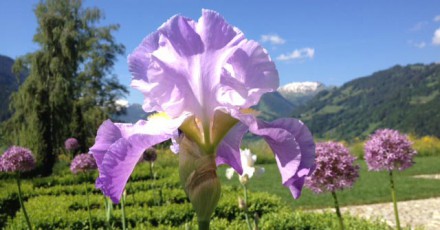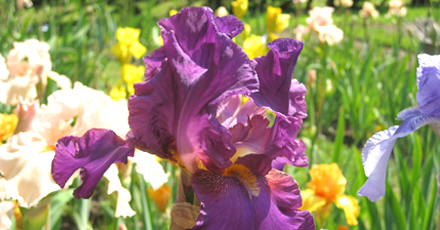How to Plant and Care for Bearded Irises
All You need to know about Bearded Irises
Bearded Irises are easy to grow and hardy in temperatures ranging from +35C/-20C.
- High Impact (image 1)
- Long Lasting - Will last for 20+ years with right care
- Wide Colour Palette - 'Colours of the Rainbow' (image 2)
- Deserving of a place in your garden and can become a real highlight/mainstay
-
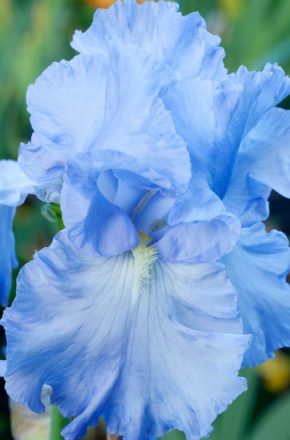
- 1) High Impact Iris
-
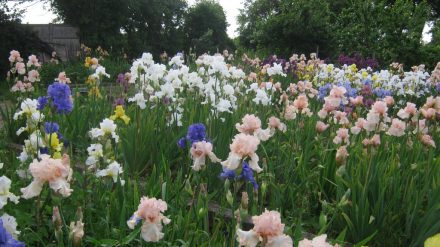
- Wide Colour Palette – The Colours of the Rainbow
The Basics
- Right Plant - Focus on Quality / Suitability / UK grown
- Right Place - South facing in a sunny spot (image 3)
- Good Drainage Essential - Free draining soil and PH neutral
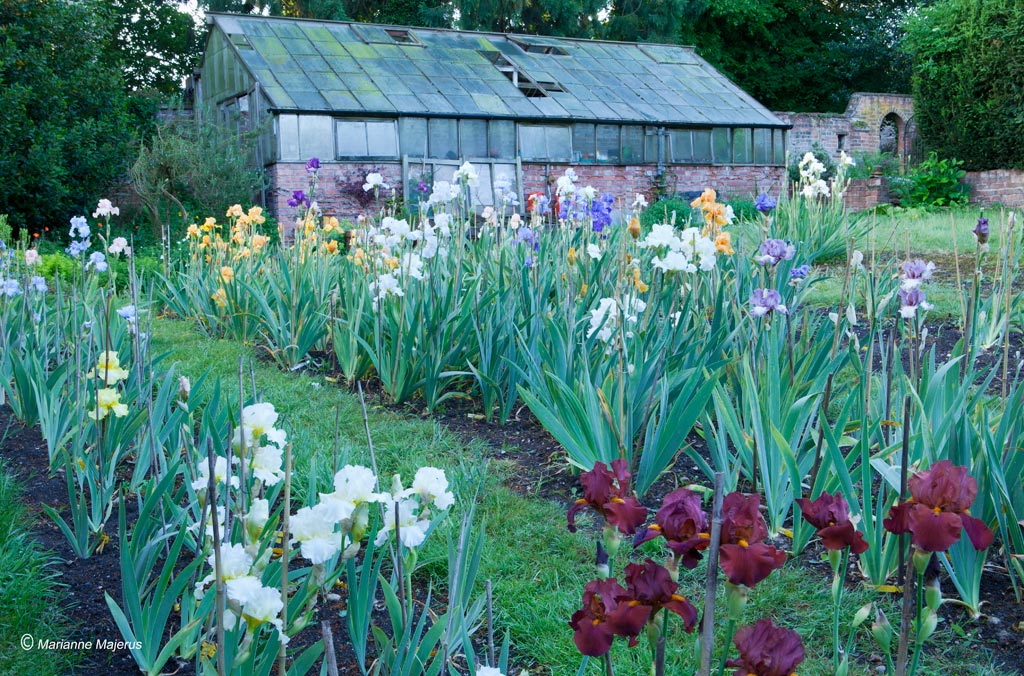
3) Irises are best planted in a South Facing sunny location
Planting
Step 1 - Choose a healthy plant / cut leaves back to 6" (15cm)
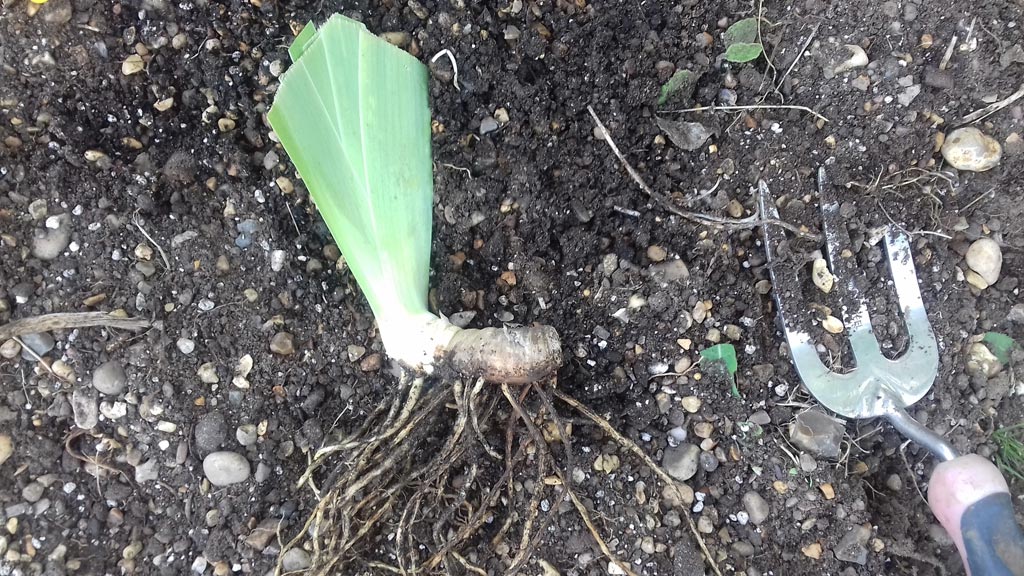
A healthy plant with leaves cut back to 6" (15cm)
Step 2 - Make a mound
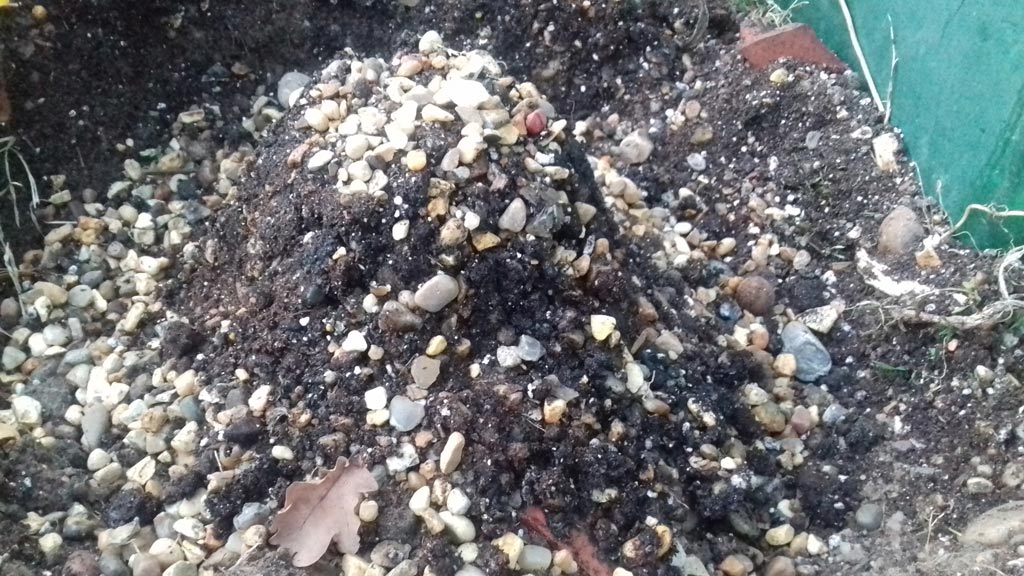
A mound ready for an iris
Step 3- Place rhizome on top - Splay roots around the mound
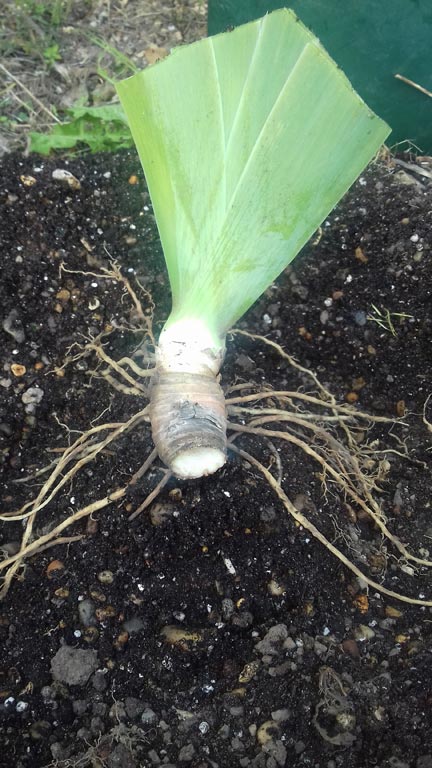
A rhizome with roots splayed around the mound
Step 4 - Back fill to leave top half of rhizome exposed to sun
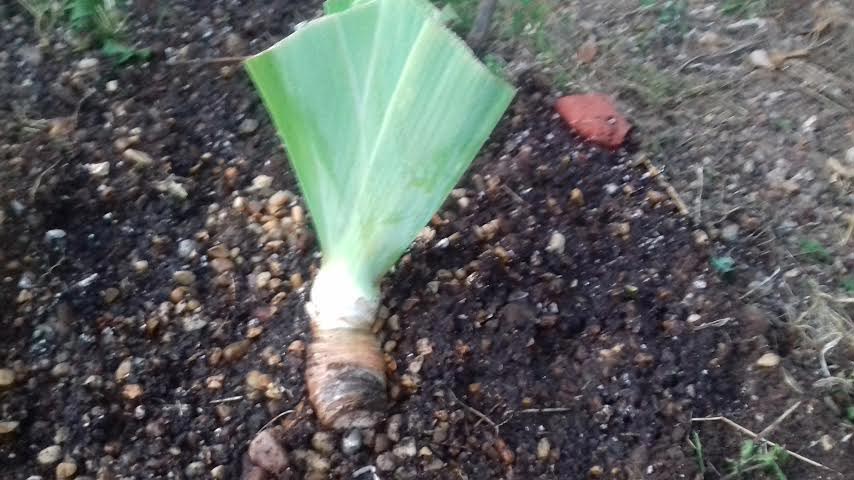
After back filling, the roots are covered and the top of the rhizome remains exposed
Step 5 - Plant in groups of three (same variety) / allow plants to 'breathe'
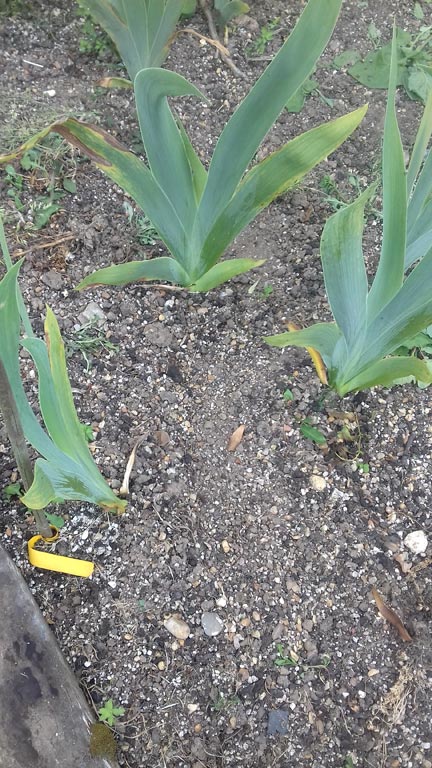
Plants should be 9/12" (23/30cm) apart
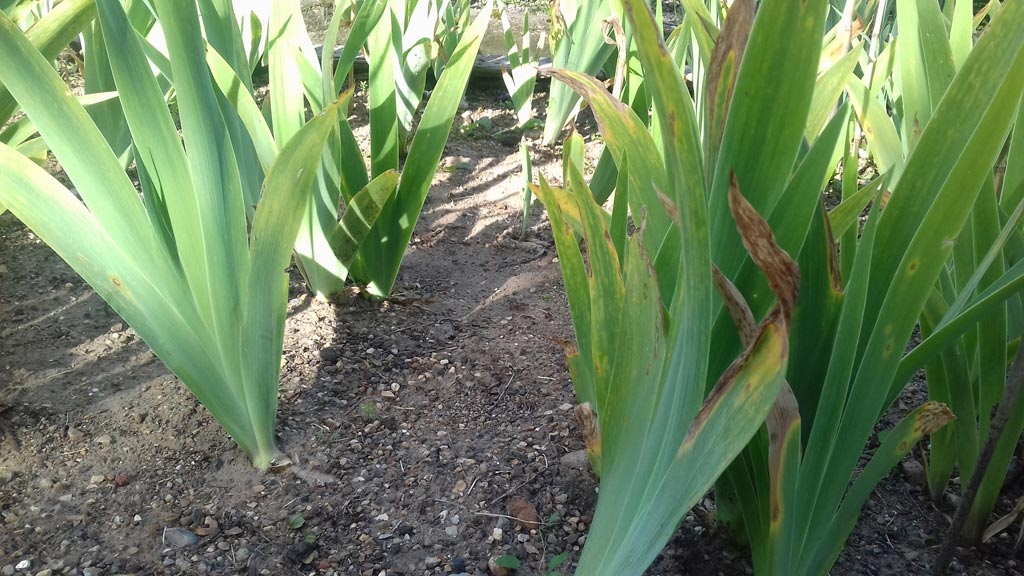
There should be 18" (46cm) between rows of irises to allow good air flow
Step 6 - Establishment
- Handful of Bone Meal around each plant
- Fork in
- Water
- Rhizomes must be left exposed to allow the sun to bake and create the flower cells to ensure good flowering the following year.
- Never use nitrogen-based feed. This will stimulate leaf growth and cause the rhizome to rot.
- Do not over water. In dry conditions water lightly every other day, until the leaves start to ‘shoot’ and roots take hold, then stop.
- Planting season- Any time between April and October.
Dividing Your Irises - Essential to ensure continued flowering
Traditional Method
How often - Every four/five years
When - After flowering (July/September)
What you do
- Dig up the entire clump
- Discard old/rotten rhizomes (image 10)
- Choose healthiest young rhizomes (image 11)
- Cut back leaves to 6" (15cm) 'fan' shape
- Replant as per Step 5 above
-
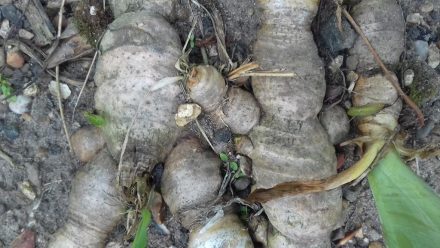
- 10) Old rhizomes to be discarded
-
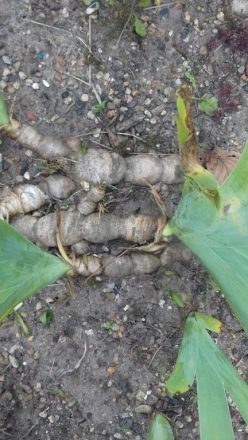
- 11) Healthy rhizomes with live shoots to be kept
Doddington Method
How often - Annually
When - Immediately after flowering (July)
Why - Creates space and leaves healthy rhizomes undisturbed that will flower consistently each year
Benefits - Quick/easy and much less disruption to plants and flowering cycle.
What you do
- Choose the healthiest irises you wish to retain
- Divide the clump with a spade (image 12)
- Remove 30%-50% of the plant mass to create space (image 13)
- Cut back leaves to approx. 50% of normal height, and then again later in the year as normal
-
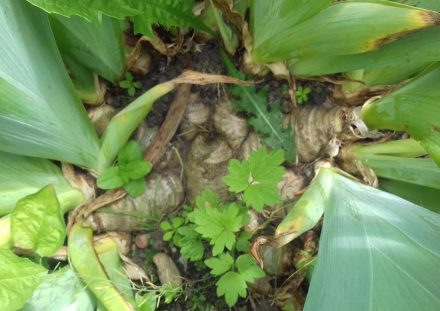
- 12) Irises ready to be divided
-
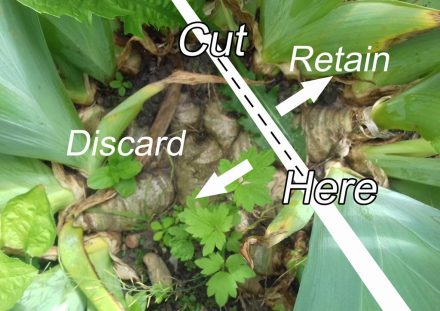
- 13) Divide as shown to remove plant mass and create space
Tall Bearded Irises must be divided every four or five years. If you don't do this, your irises will gradually stop flowering. You have two choices:
- Traditional
Caveat - there are drawbacks with this. Irises do not like being moved and frequently they will not flower the year after being split (Year 1). Flowering will improve in Year 2, and, is at its best in Year 3, but will start to reduce in Year 4. It will get worse by Year 5 which means you need to start the cycle again. The best thing to do is to rotate the irises you split and do some each year. In this way the overall impact of reduced flowering can be minimised. - Doddington
The ‘Doddington’ method works well when you have a large number of irises with the space to allow them to ‘move’. Remove 30% to 50% of the plant material each year to leave healthy rhizomes undisturbed which will flower the following year. It is important to split the irises soon after flowering (July is ideal) as this allows the flower cells to develop over the Summer. If you delay the process until later in the year, this less successful.
General Plant Care
Feed Spring and Autumn
Apply Bone Meal (not Nitrogen)
Winter Preparation (Oct/Nov)
- Remove old flowering Spikes - Push back the base of the flowering spike with your thumb until it ‘snaps’. This will ensure a clean break which will heal naturally.
- Cut back leaves to 6" (15cm) into a fan shape and remove all withered and dying leaves – this helps keep the plant clean and free from fungal infection. It also reduces cover for slugs.
Pests and Diseases
Bearded Irises are hardy and resistant to many common garden pests;
Slugs/Snails
Will eat foliage and rhizomes. Use organic Slug Pellets that will not harm garden birds and other wildlife.
Leaf Spot
Fungal disease. Worst in damp conditions and when irises are planted too close together/cut back affected leaf and burn. More serious cases apply general rose fungicide spray.
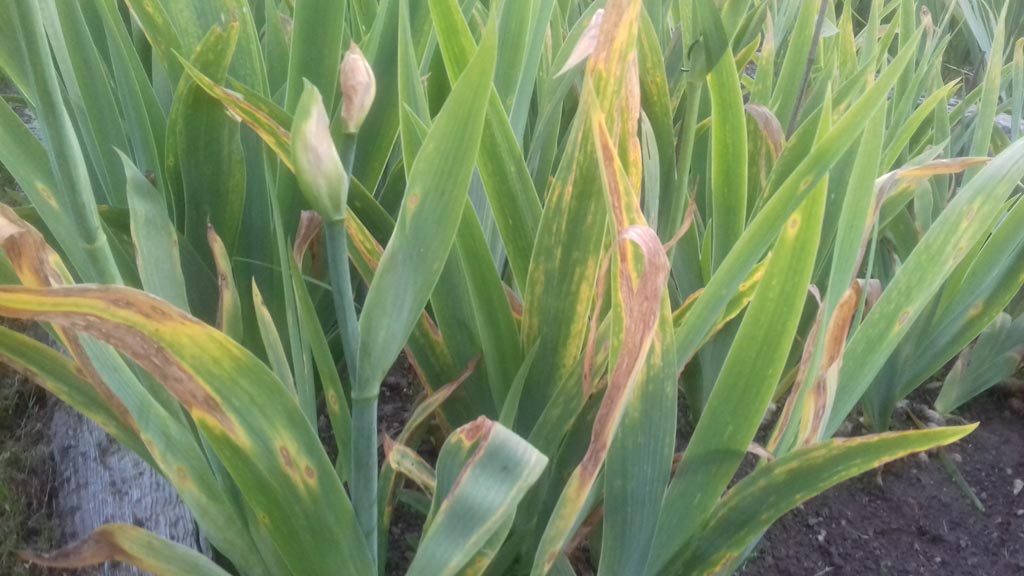
Iris with fungal disease 'leaf spot'
Rhizome Rot
Bacterial infection often caused by inadequate drainage.
- Symptoms: leaves go yellow, flowering spikes fall over.
- Solution: Cut out affected rotten areas and take back to firm plant material. Apply generous quantities Yellow Sulphur Powder to affected parts of the rhizome.
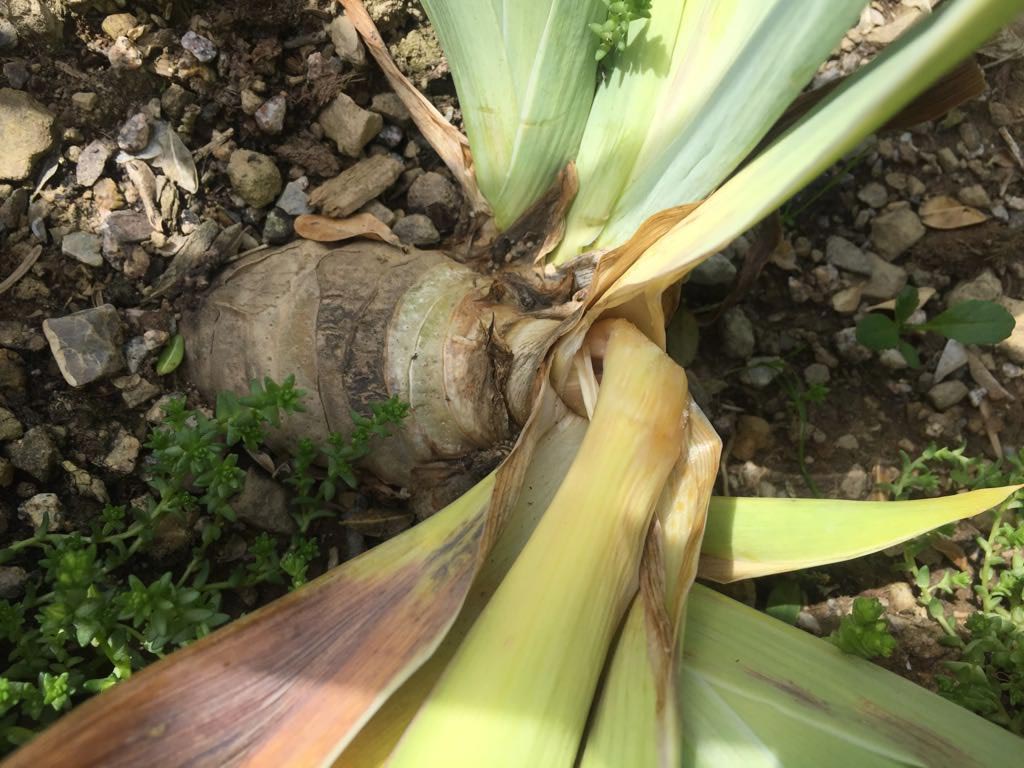
Iris showing signs of rhizome rot
In the Spring add Potash and Superphosphate to the bone meal in the proportions: 1:1:8. This will help flowering. Apply bone meal in the Autumn.
Frequently Asked Questions
Why do my irises not flower?
- Lack of sun / shading by trees
- Damp – not dry enough
- Rhizomes not divided frequently enough – every three or four years
- Rhizome planted too deep – top half must be on the surface
- Need feeding
- Wrong feed - (Nitrogen) / All leaves
- Combination of any of the above
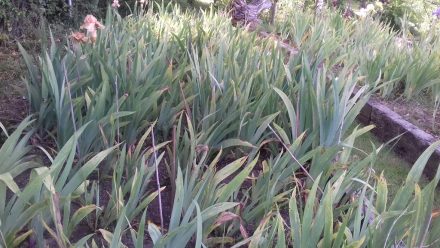
Irises in shade don't flower as readily as those in full sun
Can I grow irises in heavy clay soil?
Definitely – Beadered Irises grow well in clay, but you should improve the drainage first. Add brick rubble to base of bed, then coarse gravel; mix soil with bags of grit and peat.
How best to plant irises in a mixed border with herbaceous plants/perennials?
Many gardeners do not have the space for a dedicated iris border. You can mix Tall Bearded Irises successfully with other plants.
- Ensure rhizomes open to the sun and not shaded or covered by other plants
- Monitor Tall Bearded Irises during the growing season as growth from other herbaceous plants takes off.
What are good companion plants with Tall Bearded Irises planted in a dedicated iris bed?
For more detailed information on this topic please see our Companion Planting article.
Choose plants that do not generate excessive leaf cover that will shade the iris rhizomes
- Alliums - early/late flowering varieties/mix of the two
- Tulips – early flowering varieties
- Peonies
- Roses – those with a loose habit are best (arthur bell)
- Grasses – but be selective. Not invasive varieties.
- Formal setting – box compartments
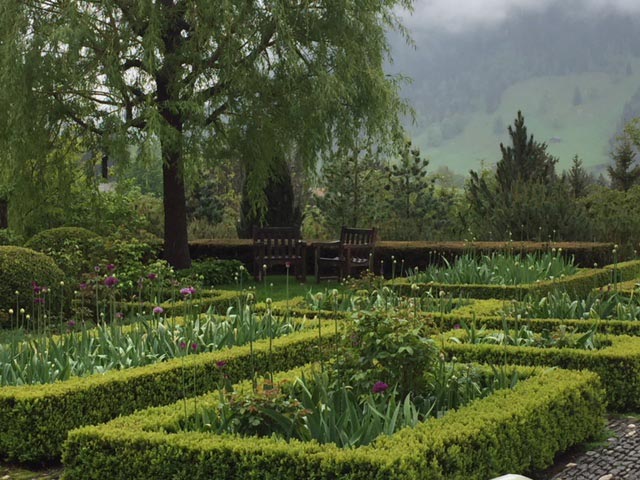
Irises planted with alliums
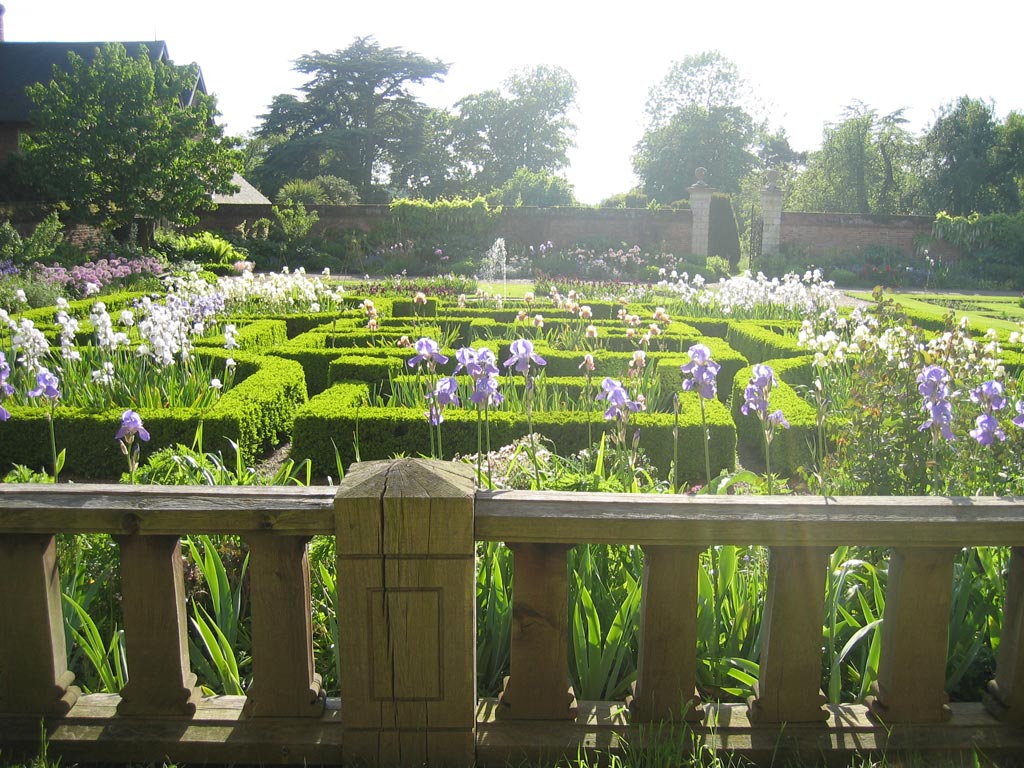
Plant in formal settings with box compartments
Should I stake my irises?
Sheltered site/not - this depends on the topography/local wind conditions and the degree of shelter provided in your garden.
Considerations - staking is advisable with small numbers of plants to safeguard from the unpredictable uk weather/may june gales. Larger borders – a matter of choice/manpower
Support - use a tough but slight stake that does not detract from the beauty of the plant; secure the plant with a soft bendable galvanised split ring, not the hard ‘springy’ kind.
Can I grow Tall Bearded Irises successfully in containers?
Definitely. Many gardeners with limited space/town gardens grow Tall Bearded Irises successfully in containers.
- Aspect – hot /sunny site is vital
- Container – chose a good-sized container/better wide and shallow than too narrow and deep
- Drainage - good drainage is always essential, but particularly with pots- add broken bricks/broken pots/gravel
- Soil - good gritty soil mix
- Feed - generous feeding with bone meal (no nitrogen)
- Pests - watch out for slugs/snails
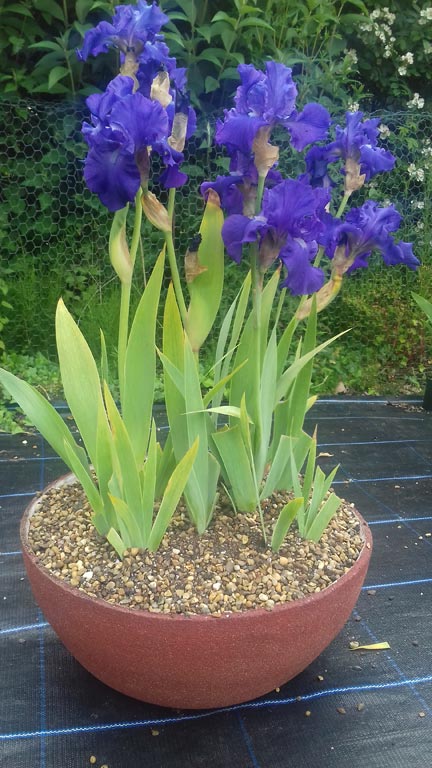
Irises can grow successfully in containers under the right conditions
Why buy British irises?
- Tried and tested in uk growing conditions
- Hardy – with right treatment will last for years
- Propagated to cope with UK wind and rain/ petals thick enough to withstand June thunderstorms
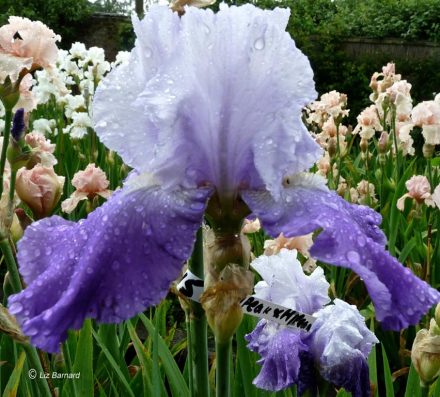
Irises bred in Britain are able to cope with British weather
Why buy our irises?
- Exclusive to English Iris Company
- Award Winning - developed from award winning stock over forty years by Bryan Dodsworth, the most celebrated Twentieth Century British Hybridiser of Tall Bearded Irises
- Pedigree - winner of twelve UK Dykes Medals (Oscar of Iris Hybridisers World)/no one had won the medal more than four times in 90 Year history of the Medal

Bryan Dodsworth - Winner of Twelve UK Dykes Medals
What Makes the Perfect Iris
The result of a highly rigorous selection process; less than fifty varieties registered in forty years from 60,000/75000 seedlings
- Perfect flower shape in proportion to stem height
- Great structure/branching that allows flowers to open away from the stem and to be enjoyed individually
- Clear/clean colours
-
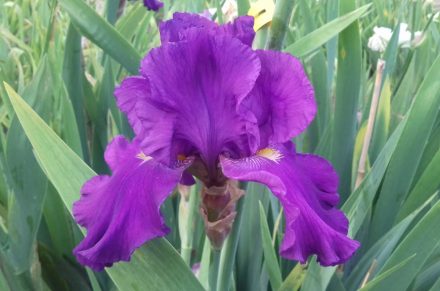
- Perfect flower shape
-
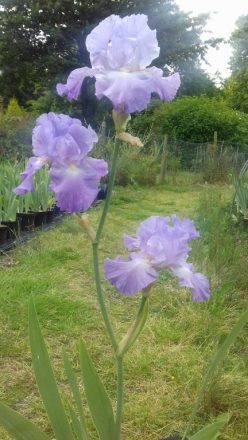
- Great structure and branching
-
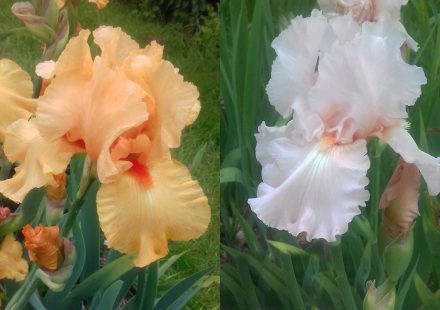
- Clear and clean colours
Where you can see our irises
- Doddington Hall, near Lincoln
- Newnham College, Cambridge
- Old Vicarage Gardens, East Ruston, Norfolk
- Marshgate House, North Walsham, Norfolk
Featured on BBC TV Gardeners' World (July 2016)


